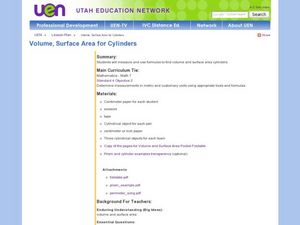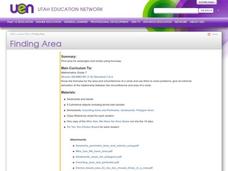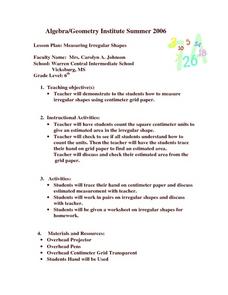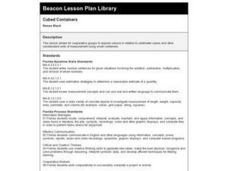Curated OER
An Introduction to Area and Perimeter
Students form rectangles by using tiles, measure area and perimeter by counting. They discover and apply rules for measuring perimeter.
Curated OER
Geometry: Area Project
Sixth graders identify and use area formulas for finding the area of geometric shapes.
Curated OER
Math Activity File
Third graders describe the difference between area and volume and also explain how various units of measure relate to one another.
Curated OER
Playground Measurement
Fifth graders find a rectangular or square object in the classroom to measure. They measure to the nearest centimeter and apply that knowledge to measuring perimeter. They recognize, describe, and determine surface area and volume of...
Curated OER
How much room?
Students examine the amount of usable space that exists in their classroom using square meters and square centimeters. They apply the information to predict the ideal size of a classroom.
Virginia Department of Education
Pythagorean Theorem
Investigate the meaning of the Pythagorean Theorem through modeling. After comparing the area of the square of each side, individuals cut triangles and squares to facilitate the comparison.
Curated OER
Grade 3: What Can I Make with 30 Centimeters?
Third graders create polygons with perimeters of 30 centimeters, use the centimeter grid paper to determine the area of each shape, and organize the shapes to make generalizations from the patterns they see.
Curated OER
What a Square
Young scholars examine the painting "Old Man With A Gold Chain" by Rembrandt. They identify geometric shapes in the painting, measure these shapes and compare the relationships of these measurements.
Curated OER
Volume, Surface Area for Cylinders
Seventh graders explore the concept of volume and surface area of cylinders. In this volume and surface area of cylinders lesson, 7th graders break cylinders into their base shapes of a circle and a rectangle. Students discover that...
Curated OER
Finding Area
Seventh graders explore the concept of area. In this area lesson, 7th graders determine what measurements are necessary to find the area of a rectangle and circle. Students use area formulas to calculate area or rectangles and circles.
Curated OER
Explorations in Measurement
Students define length and area. They identify materials that can be measured with a rule and yardstick. They measure length and area when given an object.
Curated OER
Cube Models
Sixth graders are introduced to the concepts of area and volume. In groups, they work together to build models of square centimeters in which they are given no instructions. To end the lesson plan, they record the dimensions of each...
Curated OER
Picket Fence Around the Garden
Students design different shaped plots and determine the perimeter, area and shape of each. They compare the shapes that have the same area but may have different perimeters.
Curated OER
Introducing Powers and Models
Students construct two dimensional models to illustrate squared numbers. For this geometry lesson, students use graph paper and an x/y axis to build squares exponentially. Students identify powers and relationships between various...
Curated OER
Digger and the Gang
Help online friends Digger and Sprat from the BBC series to solve math problems! In a series of activities, your class will use data sets to calculate measurements, averages, means, and probabilities. The class completes worksheets and...
Curated OER
Finding the Area of Triangles
Twelfth graders apply the formula for finding the area of a triangle to various problems. They work real life problems for finding the area of a bathroom and the cost of tiling it. They play a game, Triangle Bingo, where they match...
Curated OER
Amazing Transpiration
Learners observe a leaf and discuss the way that water is released from a leaf through its stomata. For this water cycle lesson, students calculate how much water leaves produce from a whole tree.
Curated OER
Building Models
Fifth graders build models. In this measurement lesson, 5th graders build paper models to represent square centimeters, square inches, square feet, cubic centimeters, cubic inches, cubic feet, and perimeter.
Curated OER
Measuring Irregular Shapes
Sixth graders practice measuring shapes that do not have a common shape. They practice using centimeter grid paper to make the measurements. Students also use estimation skills after measurements are taken.
Curated OER
Shape Makes a Difference!
Students learn the difference between perimeter and area by watching a video and a hands on activity.
Curated OER
Math On Your Lap Quilt
Get creative juices flowing when you allow groups to figure out a procedure for how to find the area of squares and rectangles. They may use the individual patchwork blocks, or they may design one using the Design Template.
Curated OER
Grid Frame Mapping
Students map and describe small area of the schoolyard and discuss habitats.
Curated OER
Cubed Containers
Learners explore volume in relation to centimeter cubes and other nonstandard units of measurement using small containers. They will use hands-on materials to practice this concept. You will need small objects and containers to set this up.
Curated OER
Measure Mania
Groups of students rotate through five classroom stations to estimate, measure, and record volume, length, weight, mass, and area using both customary and metric measure. They evaluate their data to determine how close their estimates...

























